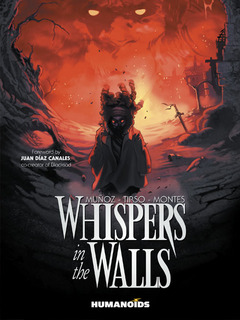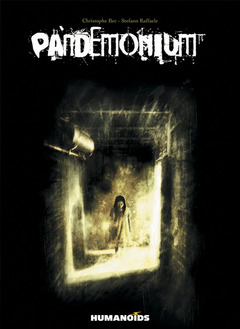My interest in comics ebbs and flows. So much that is published is
embarrassingly bad, but I still love the medium, and so I want there to
be books that are good. English language comics publishing remains
dominated by superheroes, an exhausted genre which was great when the
stories were aimed at young lads, but which stinks now that the target
audience is 30/40something anally retentive boy-men. Nor have I ever
been able to develop a taste for autobiographical “indie” comics, which
are often (though not always) a) boring b) poorly drawn and c)
solipsistic. As a result, I search hopefully for European comics in
translation, where the standard of craft is usually higher, there is a
broader spread of genre and there are no images of Cyclops in a red thong.

Anyway, two recent European graphic novels that caught my eye are Whispers in the Walls by the Spanish creative team of Munoz, Tirso and Montes and Pandemonium, by the French-Italian team of Bec and Raffaele. Whispers
was written by a professional screenwriter who has worked with
Guillermo del Toro, so I was hopeful that he might understand the basics
of plot and characterization in a way so many American comics writers
do not, while I knew nothing about the creative team behind Pandemonium
but the setting- a TB sanatorium in the 1930s- was unusual so I had
high hopes. Both books are works of horror, featuring children in
terrifying situations, and no images of Cyclops in a red thong.
Whispers in the Walls is about a group of children being
kept in a mysterious infirmary in Czechoslovakia in 1949. Immediately,
this caused me problems. I detest the lazy Hollywood habit of setting
supernatural stories in an amorphous “Eastern Europe” filled with
castles, mountains, yokels and hidden races of vampires. Yes, yes I know
Dracula came from that general area but what the f***? I lived in
Prague for a year in the late 90s and discovered a resolutely
un-mysterious heritage theme park, populated by laid back materialists
who like beer and hate conflict. Vampires? My ass.

More problematic still is the book’s time-frame: 1949, when the
Czechs and Slovaks were already living under a Stalinist government,
complete with all the boredom, poverty and repression that entailed. Now
a tale of the supernatural set in Klement Gottwald’s Prague might
actually have been very interesting, but in Whispers history simply does not exist. Instead we’re in the generic “Eastern Europe” of Ghost Rider: Spirit of Vengeance, only without the self-mocking absurdity. In fact, the basic set up is very close to Guillermo del Toro’s Blade II, with a race of vampires hidden for millennia emerging from the shadows, dungeons, a secret plan to take over world, etc.
Many people like this kind of thing. And if you don’t object to Eastern Europe a la Eli Roth, then Whispers
is a solid yarn, with good characterization, werewolves and vampires,
dramatic battle scenes, and a consistently unfolding process of
self-discovery as the children learn terrible truths about themselves
and the world. It is not a bad example of its genre, and if you are not
bored by vampires as I am, you’ll probably dig it.
Pandemonium I enjoyed a lot more, even though it is set in the Waverly Hills Sanatorium, a staple of shitty Travel Channel shows on haunted places, and where I believe VH1 even filmed an episode of the Celebrity Paranormal Project starring
Gary Busey and a host of utter nonentities. It’s a testament to the
atmospheric power of Bec’s writing that I didn’t make the connection
until I was about halfway through.

Although there are touches of the supernatural in the story, the horror at the core of Pandemonium
is not fantastical nonsense about vampires, the kind of sanitized
fantasy that nobody believes, but rather the all too real terror felt by
those who are powerless in the face of institutional violence. The
premise is simple: a woman brings her child to the sanatorium to cure
her of TB, and soon both mother and daughter are trapped by a venal and
corrupt administration with no interest in healing, that abuses its
patients and conceals the cartloads of bodies being dragged off each
night for incineration.
Bodies hang on meat hooks, skulls are surgically opened, women are
drugged and raped, and at least some of this stuff really happened,
though Bec keeps that aspect of his narrative ambiguous. The artwork
throughout is excellent; Raffaelle is not bored by perspective or
seduced by wacky page layouts, his faces are expressive and his
landscapes are meticulously reproduced. Meanwhile the supernatural
aspect of the story adds both an atmosphere of the uncanny and a subtext
of social commentary, as it is the ghosts of disgraced women and
segregated blacks that appear to the young residents of the sanatorium.
This is precisely the kind of acutely observed historical detail that is
missing from Whispers in the Walls, but which adds so much
weight and plausibility to a narrative. In this Bec is carrying on in a
fine French tradition of well-researched comics set in America. Moebius’
Blueberry series is the most famous instance, but also worth mention is Miss: Better Living Through Crime, a French noir set in prohibition era New York which, were it not for Torpedo by the Spaniards Abuli and Bernet would be the best noir comic ever created.
And yet, for all that the setting is American, at its core Pandemonium
remains an intensely French book as the bleak and chilling climax,
utterly bereft of sentimentality makes clear. American genre fiction
just doesn’t do that kind of thing to children, and I don’t even think
that’s a criticism. Although it’s not quite as harrowing as an image of Cyclops in a red banana hammock, Pandemonium is a good, dark tale of psychological horror, deserving of a much wider audience.